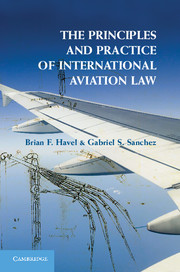Book contents
- Frontmatter
- Contents
- Preface
- Acknowledgments
- Table of Abbreviations and Acronyms
- 1 What is International Aviation Law?
- 2 The Foundations of Public International Aviation Law
- 3 The International Law Regime for Trade in Air Services
- 4 The International Law Regime for Airline Investment and Global Alliances
- 5 The International Law Regime for Aviation Safety and Security
- 6 The International Law Regime for Aviation and the Environment
- 7 The International Law Regime for Air Carrier Liability and Surface Damage
- 8 The International Law Regime for Aircraft Financing and Aircraft Nationality
- Afterword
- Select Bibliography
- Table of Authorities
- Index
- References
4 - The International Law Regime for Airline Investment and Global Alliances
Published online by Cambridge University Press: 05 June 2014
- Frontmatter
- Contents
- Preface
- Acknowledgments
- Table of Abbreviations and Acronyms
- 1 What is International Aviation Law?
- 2 The Foundations of Public International Aviation Law
- 3 The International Law Regime for Trade in Air Services
- 4 The International Law Regime for Airline Investment and Global Alliances
- 5 The International Law Regime for Aviation Safety and Security
- 6 The International Law Regime for Aviation and the Environment
- 7 The International Law Regime for Air Carrier Liability and Surface Damage
- 8 The International Law Regime for Aircraft Financing and Aircraft Nationality
- Afterword
- Select Bibliography
- Table of Authorities
- Index
- References
Summary
The Nationality Rule Excludes Single-Carrier Networks
As we noted in Chapter 3, the trade environment for international aviation is bedeviled by the requirement that airlines designated by a State under its bilateral air services agreements (ASAs) must be “substantially owned” and “effectively controlled” by that State or by its citizens. Moreover, that requirement has been tightened in recent years in many ASAs by making explicit what had always been an implicit assumption in bilateral aviation relations: that the designated airline must also be legally established and have its principal place of business in the designating State. To reinforce these treaty-based provisions, most States have enacted domestic laws that prohibit foreign ownership and control of their national air carriers. All of these restrictions, bundled together as the “nationality rule,” mean that no single air carrier is legally able to generate a freestanding global route network using any combination of wholly owned subsidiaries in strategic locales or cross-border mergers or acquisitions involving foreign partners. Airlines, in a phrase, do not do business like any other business.
Rise of Strategic Alliances
As we will see, however, there is some evidence that the high-water mark of the nationality rule has passed, and that States in some regions are showing tolerance for transnational airline mergers that do not conform to the rule. In the meantime, many international carriers have sought to trump the nationality rule by forming single-identity strategic commercial alliances with foreign partners. By collaborating on fares, routes, marketing, and consumer perquisite programs, airline alliance partners can replicate, with varying degrees of intensity, the unified brand identity and service that a hypothetical “globalized” airline would be able to offer. These collaborations are not without controversy, however. As a former Qantas Airlines chief executive observed, airline alliances involve “sitting in a room to plan your business with your competitors.” Strategic alliances among companies that are normally in full-throated competition with each other are bound to attract antitrust scrutiny. But, as we will see, a vestigial power of antitrust exemption inherited by the U.S. Department of Transportation (DOT) from the era of airline regulation has enabled the three global alliances that include U.S. airlines to operate mostly outside that kind of scrutiny. The Department’s approval of the alliances seems to have influenced competition law enforcers in other regions to take a similarly benign view.
- Type
- Chapter
- Information
- The Principles and Practice of International Aviation Law , pp. 123 - 172Publisher: Cambridge University PressPrint publication year: 2014



